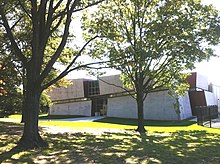National Museum of Health and Medicine

The new NMHM facility,
which opened on September 15, 2011. |
|
|
Location within Maryland
|
|
| Established | 1862 (new building, 2011) |
|---|---|
| Location | 2500 Linden Lane, Silver Spring, Maryland |
| Coordinates | 39°0′32″N 77°3′14″W / 39.00889°N 77.05389°WCoordinates: 39°0′32″N 77°3′14″W / 39.00889°N 77.05389°W |
| Type | Medicine, Military medicine |
| Visitors | 40,000-50,000 annually |
| Public transit access |
|
| Website | www |
The National Museum of Health and Medicine (NMHM) is a museum in Silver Spring, Maryland, near Washington, D.C. The museum was founded by U.S. Army Surgeon General William A. Hammond as the Army Medical Museum (AMM) in 1862; it became the NMHM in 1989 and relocated to its present site at the Army's Forest Glen Annex in 2011. An element of the Defense Health Agency (DHA), the NMHM is a member of the National Health Sciences Consortium.
The AMM was established during the American Civil War as a center for the collection of specimens for research in military medicine and surgery. In 1862, Hammond directed medical officers in the field to collect "specimens of morbid anatomy...together with projectiles and foreign bodies removed" and to forward them to the newly founded museum for study. The AMM's first curator, John H. Brinton, visited mid-Atlantic battlefields and solicited contributions from doctors throughout the Union Army. During and after the war, AMM staff took pictures of wounded soldiers showing effects of gunshot wounds as well as results of amputations and other surgical procedures. The information collected was compiled into six volumes of The Medical and Surgical History of the War of the Rebellion, published between 1870 and 1883.
During the late 19th and early 20th centuries, AMM staff engaged in various types of medical research. They pioneered in photomicrographic techniques, established a library and cataloging system which later formed the basis for the National Library of Medicine (NLM), and led the AMM into research on infectious diseases while discovering the cause of yellow fever. They contributed to research on vaccinations for typhoid fever, and during World War I, AMM staff were involved in vaccinations and health education campaigns, including major efforts to combat sexually transmissible diseases.
...
Wikipedia

